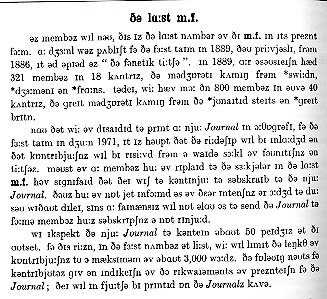There should be a one-to-one correspondence between a speech sound and the symbol used to represent it. A symbol should always represent the same sound, regardless of the language being transcribed. A sound should always be represented by the same symbol.
Since there are many more speech sounds than there
are letters of the Roman alphabet, many new symbols had to
borrowed or created. Most were created by modifying the
letters of the Roman alphabet in some way, for example,
by using small capitals as in [ ,
,
 ,
,
 ],
turning the letter backwards or upsidedown as in
[
],
turning the letter backwards or upsidedown as in
[ ,
,
 ,
,
 ],
or by extending the tail of the letter or adding some
other flourish, as in
[
],
or by extending the tail of the letter or adding some
other flourish, as in
[ ,
,
 ,
,
 ].
In some cases, the association resorted to less
familiar letters from some of the Roman-based
alphabets of Europe, e.g.,
[
].
In some cases, the association resorted to less
familiar letters from some of the Roman-based
alphabets of Europe, e.g.,
[ ,
,
 ,
,
 ,
,
 ],
or letters of the Greek alphabet, e.g.,
[
],
or letters of the Greek alphabet, e.g.,
[ ,
,
 ,
,
 ].
In only a few cases were entirely new symbols
like [
].
In only a few cases were entirely new symbols
like [ ]
or [
]
or [ ]
created.
]
created.
The number of speech sounds that the human vocal tract can produce is vastly greater than the number of unique symbols that any group would want to invent or any person would want to memorize. In order to solve this problem, the IPA includes a number of diacritics, small accent marks that can be placed above, below, or next to a major symbol to indicate that the sound it represents in this case is slightly different from the sound it normally represents. Some examples:
- [
 ] --
the circle diacritic indicates that the sound being
transcribed is just like an ordinary [n], except that the
vocal folds are not vibrating.
] --
the circle diacritic indicates that the sound being
transcribed is just like an ordinary [n], except that the
vocal folds are not vibrating.
- [
 ] --
the plus sign under the [k] an "advanced" sound. This
sound is made with the tongue hitting the roof of the
mouth a little further forward than it does for an
ordinary [k].
] --
the plus sign under the [k] an "advanced" sound. This
sound is made with the tongue hitting the roof of the
mouth a little further forward than it does for an
ordinary [k].
- [
 ] --
a nasalized [o], exactly like a regular [o] but with air
flowing through the nose as well as the mouth.
] --
a nasalized [o], exactly like a regular [o] but with air
flowing through the nose as well as the mouth.
 A page from the "Maître
phonétique", the journal that the International
Phonetic Association used to
publish entirely in its phonetic alphabet.
A page from the "Maître
phonétique", the journal that the International
Phonetic Association used to
publish entirely in its phonetic alphabet.